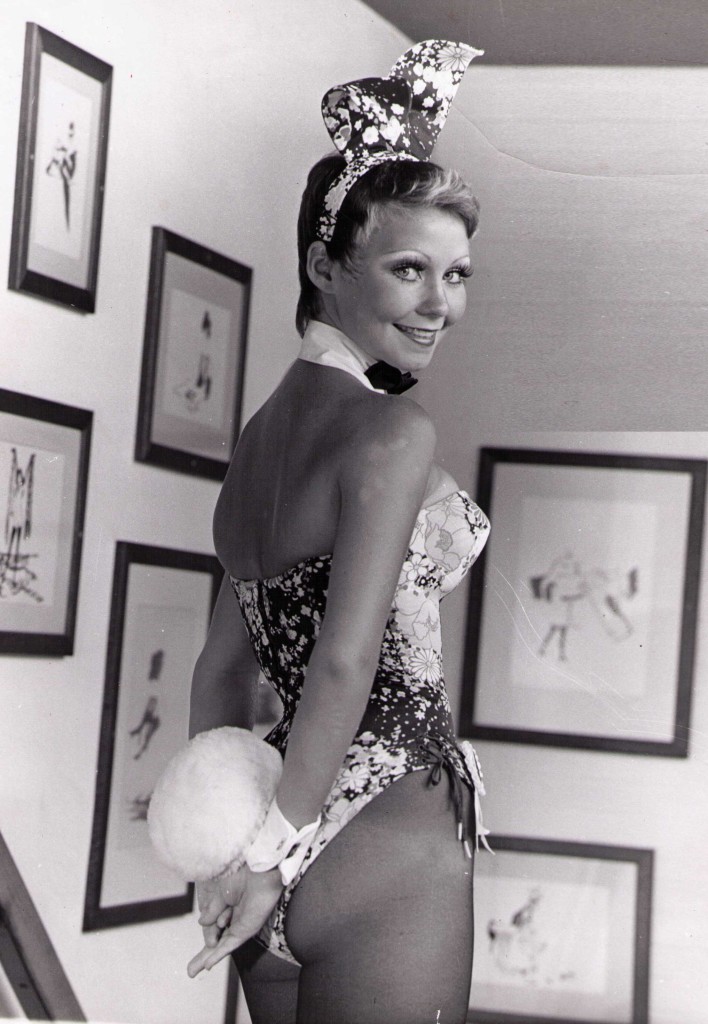Candace Jordan
Reflections on a Bunny Tale
She’s everywhere. Attend any area social function and there’s Candace Jordan, easily recognizable and known by everyone who’s anyone. There’s no doubt you’ve heard about her ties to one of the city’s most notorious publications – Playboy – but you may not know about her journey from small-town model to becoming the face of Chicago’s social and philanthropic community.
HUMBLE BEGINNINGS
Then known as Candy Collins, she grew up in Dupo, Illinois, a small railroad town on the banks of the Mississippi River. “You could actually see the St. Louis Arch from our town,” she recalls.
As a teenager, she had a passion for photography that led to a modeling job at St. Louis’ Famous-Barr department store. “I went over to the audition on a lark and they hired me,” she says. “It was around the time when ‘still lifes’ were really popular, and I loved to stand on the pedestals in the store. I was also the fashion coordinator, at 14 years old, directing all these models.”
Candy Collins didn’t know much about Playboy when she auditioned for a job at the St. Louis Playboy Club at age 19. “I knew I wanted a change,” she recalls. “I had a scholarship to Saint Louis University but overextended myself in high school. I was an overachiever and, quite frankly, exhausted. I’m competitive, so going through that again in college just wasn’t appealing to me. So when my friend said they were building this new Playboy Club I was all over it. They hired me and I loved it from the very beginning.”
 A CHANGE OF SCENERY
A CHANGE OF SCENERY
Ms. Collins wasn’t old enough to serve alcoholic drinks at the Playboy Club, so she worked the door and pool tables. “I became a championship bumper pool player,” she laughs. “I’d play for money even though it was illegal, but I made a fortune. Clients – brawny, beer-drinking men – came in, saw a girl in a Bunny costume looking ‘feeble’ and said, ‘Let’s play the little girl in a game of pool.’ But I could even jump bumpers and do it behind my back.”
During her time at the St. Louis Playboy Club, Ms. Collins shot a nude pictorial for the magazine called Best Bunnies (she was named Bunny of the Year in 1976). “I was never self-conscious about my body, and my parents never had any qualms about me being a part of Playboy,” she insists. “Whatever I wanted to do was fine with them because they trusted my judgment. I was an only child – only children usually grow up like that, older than their years.”
When the Best Bunnies photo spread hit the stands, it was an instant hit. Playboy headquarters in Chicago called Ms. Collins to ask if she was interested in transferring to Chicago. She hopped in her MGB convertible and headed up I-55 to her new home at Hugh Hefner’s mansion on State Parkway. “I’ll never forget it,” she says. “The car held only a tiny suitcase in the luggage rack, so I packed a small bag and literally leapt into the unknown. I pulled up to the Playboy Mansion, and a butler in black tie answered the door and asked, ‘May I take your luggage?’ I said, ‘Yes, you may!’ and got very comfortable very quickly.”
Ms. Collins left her small-town mentality behind once she entered the big city. “People in St. Louis and Dupo were much more narrow-minded, so I thrived in Chicago. I always felt like a square peg in a round hole down south. But in Chicago I was free to be me, surrounded by like-minded people, all fashion lovers.”
Working the door at the Playboy Club on Walton Street, Ms. Collins often interacted with the magazine’s art directors who worked upstairs. Whenever they needed someone for a quick photo shoot, they always called for Candy Collins. “I was very lucky they liked me, and I was photogenic,” she explains. “So they eventually used me for all their international club sales. They had life-size posters of me in all the clubs around the world, and I was in the magazine for Playboy Club sales. There were full-page pictures of me acting like I was serving someone drinks. And that kind of led to the centerfold.”
PLAYBOY’S GOLDEN AGE
When Ms. Collins was asked to test for a centerfold, she jumped at the chance. “Being a centerfold was and is the holy grail of pictorials,” she affirms. “It usually took Hef a long time to decide whether or not you’d make it; most women went through a lot of tests. I did one test and he said yes. I was in their biggest issue at the time, the December 1979 issue with Raquel Welch on the cover. And that, at the time, was the biggest issue they ever had so it was a real honor.”
For her centerfold, Ms. Collins stopped going by her nickname, Candy. “As far as a conscious decision to stop using Candy and start using my given name, that didn’t happen,” she explains. “Rather, it was simply outgrowing a nickname I had as a child. When I started at the Club, Candy fit better on the rosette on my costume. But when it came time for my centerfold, I felt more comfortable using my full name. I still have old friends who call me Candy, but it’s a name for little girls…not for the woman I am now.”
Living in what Ms. Collins calls ‘The Golden Age’ of Playboy, she says the ‘70s was a time of diversity. “All the girls were different in terms of ethnicity and body shape. Shortly after that, the girls became cookie cutter – all blonde and resembling Hef’s girlfriends. However, I participated in the last Playmate hunt in Chicago and am happy to know they’re now looking for natural women – no enhancements. I think they want to get back to why Playboy became so popular in the first place. It’s about getting back to the real girl next door. So I have great hope for the magazine.”
THE NEW CANDACE
Ms. Collins went on to have a successful modeling career, married businessman Charles Jordan, took his name and continued to evolve into the social butterfly and widely read journalist you see today. “Reinvention isn’t something that’s conscious,” she says. “It’s about taking chances and the path that becomes available to you. I’m always looking for the next thing that keeps my interest. And by nature I guess that means ‘reinvention.’ Each chance leads to a different destination.”
Take Ms. Jordan’s freelance job at the Chicago Tribune. “It all started because of my blog at Today’s Chicago Woman,” she says. “When I was the magazine’s fashion editor, Sherren Leigh said I should write a blog. I replied, ‘What the hell’s a blog?’ I had no idea! So I wrote about things I did, trends I saw. People stopped me in the street to tell me how much they liked my ideas. So it eventually led to my own personal blog and becoming one of the first bloggers on ChicagoNow.com. Then ChicagoNow’s Jimmy Greenfield recommended me to the Tribune when they were looking for a social columnist and the rest is history.”
If she could offer one piece of advice to women looking to reinvent themselves, Ms. Jordan says, “Embrace rejection. We all experience it, so why not make it work for you rather than let it affect you negatively? When I first started modeling in New York, Ford was the big agency in town. I made an appointment for a go-see with Eileen Ford, founder/owner. She said, and I remember it exactly, ‘The length from your knees to your ankles is too short.’ And that was that. Fast-forward to now and who do you think my agency is in Chicago?”

Leave a Reply